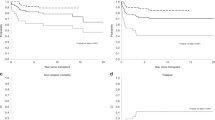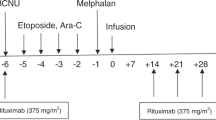Summary:
Our previously published study showed promising results of autologous stem cell transplantation (ASCT) in patients with primary resistant Hodgkin's disease (HD). Probabilities of overall survival (OS) and progression-free survival (PFS) at 3 years were 55 and 36%, respectively. The present study was undertaken to compare these results with conventionally treated patients and thus evaluate therapeutic options. Retrospective data on 76 adult patients who underwent ASCT were matched with 76 conventionally treated patients from 17 centers. Comparison of clinical characteristics in both groups showed that ASCT patients were younger (24 vs 31.5 years, P=0.001), more frequently presented with ‘B’ symptoms (P=0.03) and that more patients treated with chemotherapy (CT) had elevated LDH (P=0.03). In univariate analyses, bulky disease (P=0.0043) and complete resistance to standard CT (P=0.051) were found to be risk factors for OS. In a multivariate survival analysis only bulky disease was found to an independent prognostic factor (P=0.005). There was no difference in survival between the treatment groups with 5 years OS 33.7 (CI: 23–46) in the ASCT group and 35.6% (CI: 25–50) for the CT group (P=0.92). We conclude that ASCT is not superior to standard CT for treatment of patients with primary refractory HD.
This is a preview of subscription content, access via your institution
Access options
Subscribe to this journal
Receive 12 print issues and online access
$259.00 per year
only $21.58 per issue
Buy this article
- Purchase on Springer Link
- Instant access to full article PDF
Prices may be subject to local taxes which are calculated during checkout

Similar content being viewed by others
References
Reece DE, Barnett JD, Shepherd DE et al. High-dose cyclophosphamide, carmustine (BCNU), and etoposide (VP 16-213 with or without cisplatin (CBV±P) and autologous transplantation for patients with Hodgkin's disease who fail to enter complete remission after combination chemotherapy. Blood 1995; 86: 451–456.
Sweetenham JW, Carella AM, Taghipour G et al. High-dose chemotherapy and autologous stem-cell transplantation for adult patients with Hodgkin's disease who do not enter remission after induction chemotherapy: results in 175 patients reported to the European Group for Blood and Marrow Transplantation. J Clin Oncol 1999; 17: 3101–3109.
Lazarus HM, Rowlings PA, Zhang M-J et al. Autotransplant for Hodgkin's disease in patients never achieving remission: a report from the Autologous Blood and Marrow Transplant Registry. J Clin Oncol 1999; 17: 534–545.
Josting A, Rueffer U, Franklin J et al. Prognostic factors and treatment outcome in primary progressive Hodgkin lymphoma: a report from the German Hodgkin Lymphoma. Study Group. Blood 2000; 96: 1280–1286.
Yuen AR, Rosenberg SA, Hoppe RT et al. Comparison between conventional salvage therapy and high-dose therapy with autografting for recurrent and refractory Hodgkin's disease. Blood 1997; 89: 814–822.
Andre M, Henry-Amar M, Pico J-L et al. Comparison of high-dose therapy and autologous stem-cell transplantation with conventional therapy for Hodgkin's disease induction failure: a case–control study. J Clin Oncol 1999; 17: 222–229.
Czyż J, Hellmann A, Dziadziuszko R et al. High-dose chemotherapy with autologous stem cell transplantation is an effective treatment of primary refractory Hodgkin's disease. Retrospective study of the Polish Lymphoma Research Group. Bone Marrow Transplant 2002; 30: 29–34.
DeVita Jr VT, Simon RM, Hubbard SM et al. Curability of advanced Hodgkin's disease with chemotherapy long-term follow-up of MOPP-treated patients at the National Cancer Institute. Ann Intern Med 1980; 92: 587–595.
Bonfante V, Santoro A, Viviani S et al. Outcome of patients with Hodgkin's disease failing after primary MOPP-ABVD. J Clin Oncol 1997; 15: 528–534.
Ferme C, Mounier N, Divine M et al. Intensive salvage therapy with high-dose chemotherapy for patients with advanced Hodgkin's disease in relapse or failure after initial chemotherapy: results of the Groupe d'Etudes des Lymphomes de l'Adulte H 89 Trial. J Clin Oncol 2002; 20: 467–475.
Chopra R, McMillan AK, Linch DC et al. The place of high-dose BEAM therapy and autologous bone marrow transplantation in poor-risk Hodgkin's disease. A single-center eight-year study of 155 patients. Blood 1993; 81: 1137–1145.
Sureda A, Arranz R, Iriondo A et al. Autologous stem cell transplantation for Hodgkin's disease: results and prognostic factors in 494 patients from the Grupo Es-panol de Linfomas/Transplante Autologo de Medula Osea Spanish Cooperative Group. J Clin Oncol 2001; 19: 1395–1404.
Horning SJ, Chao NJ, Negrin RS et al. High-dose therapy and autologous hemato-poietic progenitor cell transplantation for recurrent or refractory Hodgkin's disease: analysis of the Stanford University results and prognostic indices. Blood 1997; 89: 801–813.
Crump M, Smith AM, Brandwein J et al. High-dose etoposide and melphalan, and autologous bone marrow transplantation for patients with advanced Hodgkin's disease: importance of disease status at transplant. J Clin Oncol 1993; 11: 704–711.
Gribben JG, Linch DC, Singer CR et al. Successful treatment of refractory Hodgkin's disease by high-dose combination chemo-therapy and autologous bone marrow transplantation. Blood 1989; 73: 340–344.
Porter D, Connors J, VanDeerlln V et al. Graft-versus-tumor induction with donor leukocyte infusions as primary therapy for patients with malignancies. J Clin Oncol 1999; 17: 1234–1243.
Carella AM, Cavaliere M, Lerma E et al. Autografting followed by nonmyeloablative immunosuppressive chemotherapy and allogeneic peripheral- blood hematopoietic stem-cell transplantation as treatment of resistant Hodgkin's disease and non-Hodgkin's lymphoma. J Clin Oncol 2000; 18: 3918–3924.
Author information
Authors and Affiliations
Corresponding author
Rights and permissions
About this article
Cite this article
Czyz, J., Szydlo, R., Knopinska-Posluszny, W. et al. Treatment for primary refractory Hodgkin's disease: a comparison of high-dose chemotherapy followed by ASCT with conventional therapy. Bone Marrow Transplant 33, 1225–1229 (2004). https://doi.org/10.1038/sj.bmt.1704508
Received:
Accepted:
Published:
Issue Date:
DOI: https://doi.org/10.1038/sj.bmt.1704508
Keywords
This article is cited by
-
High-dose chemotherapy and autologous stem cell transplant in adolescent patients with relapsed or refractory Hodgkin's lymphoma
Bone Marrow Transplantation (2010)
-
High-dose chemotherapy and autologous stem cell transplantation for Hodgkin's lymphoma in the kingdom of Saudi Arabia: King Faisal specialist hospital and research center experience
Bone Marrow Transplantation (2008)
-
Haematopoietic SCT for children and adolescents with relapsed and refractory Hodgkin's lymphoma
Bone Marrow Transplantation (2008)
-
LACE-conditioned autologous stem cell transplantation for relapsed or refractory Hodgkin's lymphoma: treatment outcome and risk factor analysis in 67 patients from a single centre
Bone Marrow Transplantation (2007)
-
Primary refractory Hodgkin's lymphoma: outcome after high-dose chemotherapy and autologous SCT and impact of various prognostic factors on overall and event-free survival. A single institution result of 66 patients
Bone Marrow Transplantation (2007)



